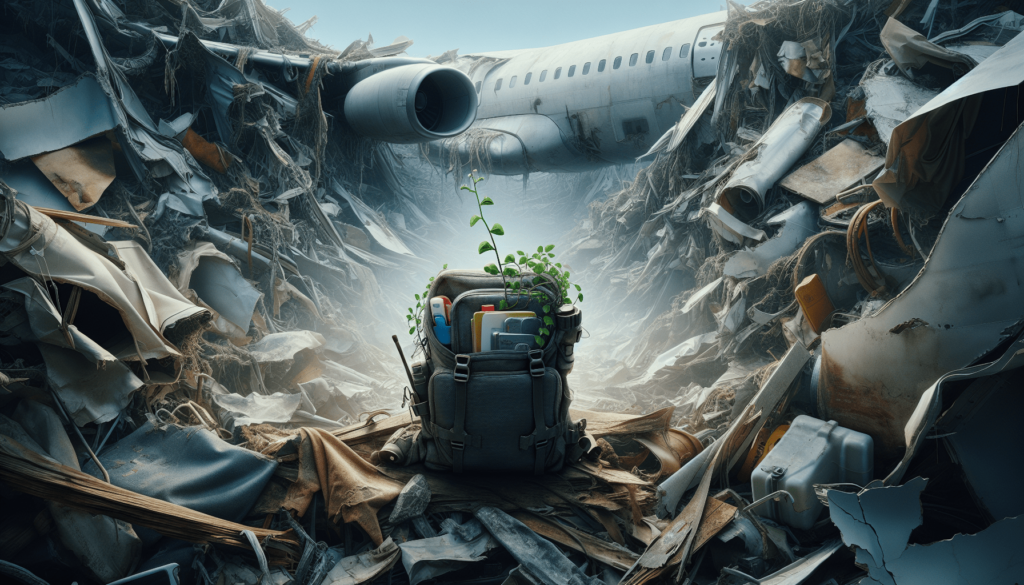Imagine embarking on a self-sufficient adventure, living off the grid with your family. Your backyard transforms into a thriving survival garden, teeming with fresh produce. You learn to identify wild plants for sustenance, while cautiously avoiding any poisonous imposters. Disaster preparedness empowers you to care for your pets during emergencies, while DIY projects like building a homemade water filter and a solar power system ensure self-reliance. Even the younger explorers get involved, mastering basic survival skills like building shelters and making fire without matches. This journey into off-grid living isn’t about preparing for doomsday; it’s about embracing self-reliance, connecting with nature, and empowering yourself and your loved ones with valuable skills. Each new lesson equips you to navigate life’s unexpected turns with greater resilience and resourcefulness. So, are you ready to embark on your own off-grid adventure? Start exploring the diverse topics in the “Plane Crash Survival: Essential Guide to Increase Your Chances,” and soon you’ll discover the empowering freedom that comes with knowing how to thrive, no matter what life throws your way.
Preparation before boarding
Before embarking on any flight, it is important to take some time to prepare yourself for potential emergencies. By following these steps, you can increase your chances of surviving a plane crash.
Research the airline’s safety record
One of the first things you should do before boarding a plane is to research the airline’s safety record. Look for information on past incidents or accidents, as well as any safety measures and protocols the airline has in place. This will give you a better understanding of the airline’s commitment to safety and help you make an informed decision about which airline to fly with.
Check the weather forecast for your destination
Another important step in preparation is to check the weather forecast for your destination. This will give you an idea of what conditions to expect when you land and can help you mentally prepare for any potential weather-related emergencies. It is always better to be prepared and aware of the weather conditions before boarding the plane.
Pack a survival kit
Having a survival kit on hand can be crucial in the event of a plane crash. Your survival kit should include essentials such as a first aid kit, a flashlight, a whistle, a pocket knife, a water bottle, and non-perishable food items. It is important to pack these items in a small bag or pouch that is easy to carry and accessible in case of an emergency.
Inform someone about your travel details
Lastly, it is important to inform someone about your travel details. This could be a family member, a friend, or even a coworker. Let them know when and where you will be flying, as well as your expected arrival time. In the event of a crash, this person can contact authorities and provide them with important information about your whereabouts.
Understanding airplane safety procedures
Once onboard the plane, it is crucial to pay attention to the safety instructions and familiarize yourself with the safety equipment on board. Doing so can greatly increase your chances of surviving a plane crash.
Pay attention to the safety instructions
When the flight attendants start giving the safety instructions, it is important to pay close attention. Even if you have heard the instructions countless times before, it is crucial to refresh your memory and be prepared for any emergencies that may arise. Listen carefully and follow along with the provided safety card to ensure that you know what to do in case of a crash.
Locate the nearest emergency exits
One of the most important things to do when you board a plane is to locate the nearest emergency exits. This information is typically provided in the safety instructions and could also be found in the safety card located in the seat pocket in front of you. By knowing where the emergency exits are, you can quickly and efficiently evacuate the plane if necessary.
Familiarize yourself with the safety equipment on board
In addition to knowing the location of the emergency exits, it is important to familiarize yourself with the safety equipment on board. This includes items such as life jackets, oxygen masks, and fire extinguishers. Take a moment to visually inspect the safety equipment in your immediate vicinity. Knowing how to properly use these items can greatly improve your chances of survival in the event of an emergency.
Choosing the safest seat on the plane
When it comes to choosing a seat on the plane, there are a few things to consider in order to increase your chances of survival in the event of a crash.
Opt for seats near the emergency exits
Seats near the emergency exits are generally considered to be the safest on the plane. These seats provide easy access to the emergency exits, allowing you to quickly evacuate in the event of a crash. However, it is important to note that not all emergency exit seats provide the same level of safety. Some seats may have additional safety features, such as extra legroom or proximity to life rafts. Therefore, it is advisable to do some research before selecting a specific seat near an emergency exit.
Consider sitting in the rear of the plane
In addition to seats near the emergency exits, seats at the rear of the plane are also considered to be safer. According to studies and crash investigations, passengers seated in the rear of the plane tend to have a higher survival rate. This could be due to various factors, such as the impact forces during a crash being lower towards the rear of the plane. Therefore, if possible, it may be beneficial to choose a seat towards the back of the aircraft.
Survival mindset and psychological preparation
In a plane crash, it is not only physical preparation that is important but also mental preparedness. Maintaining a survival mindset can greatly increase your chances of making it through the ordeal.

Stay calm and focus on your survival
One of the most important things to remember during a plane crash is to stay calm. Panic can cloud your judgment and hinder your ability to react effectively. Take deep breaths and focus on your survival. Stay positive and remind yourself that you have prepared for such situations.
Prepare mentally for the worst-case scenario
While it can be unsettling to think about the worst-case scenario, mentally preparing yourself for it can be extremely helpful in an emergency. Visualize yourself going through the necessary actions and procedures in case of a crash. This mental rehearsal can help reduce panic and ensure that you can react quickly and efficiently.
Visualize your actions in case of a crash
In addition to mentally preparing for the worst-case scenario, it can also be beneficial to visualize your actions in case of a crash. Imagine yourself assuming the brace position, protecting your head and vital organs, and evacuating the plane. By visualizing these actions, you can better familiarize yourself with the necessary steps and increase your chances of survival.
During a plane crash
In the unfortunate event of a plane crash, it is important to remember certain actions that can greatly improve your chances of survival.
Follow the instructions given by the flight attendants
During a plane crash, it is crucial to follow the instructions given by the flight attendants. They are trained to handle emergency situations and will provide you with important guidance on how to evacuate the plane and ensure your safety. Stay calm, listen carefully, and follow their directions.
Assume the brace position
One of the most important things to do during a crash landing is to assume the brace position. This position is designed to minimize the impact forces on your body and protect your vital organs. Follow the instructions given by the flight attendants on how to assume the brace position and hold it until the plane comes to a complete stop.
Protect your head and vital organs
In addition to assuming the brace position, it is important to protect your head and vital organs during a crash. Use your hands to cover your head and face, and try to shield your chest and abdomen as much as possible. By doing so, you can reduce the risk of injury and increase your chances of survival.
Exit the plane as quickly as possible
Once the plane has come to a stop, it is important to exit the aircraft as quickly as possible. Follow the emergency exit signs and make your way towards the nearest exit. Be mindful of any debris or obstacles and carefully navigate your way out of the aircraft. Once outside, move away from the plane and find a safe location to assess your injuries and await rescue.
Surviving in a crash aftermath
After surviving a plane crash, there are certain steps you should take to increase your chances of survival in the aftermath.
Assess your injuries and those of others
The first step after a plane crash is to assess your injuries and those of others. Check yourself for any visible injuries and evaluate your overall condition. If you are able, help others who may be injured and in need of assistance. Prioritize treatment for any life-threatening injuries and try to provide comfort and reassurance to those around you.
Move away from the wreckage
If it is safe to do so, move away from the wreckage of the plane. The plane may be unstable and there could be fuel leaks or other hazards present. Find a safe location where you can assess your situation and await rescue. Keep in mind that rescue teams may be dispatched to the crash site, so moving away from the wreckage can increase your chances of being found.

Find shelter and protect yourself from the elements
After moving away from the wreckage, it is important to find shelter and protect yourself from the elements. If you are in a cold environment, try to find shelter that provides insulation and warmth. In a hot environment, seek shade and protect yourself from the sun. Remember to conserve your energy and stay hydrated.
Ensure you have access to fresh water and food
In a survival situation, access to fresh water and food is crucial. If possible, try to locate a water source and collect clean, drinkable water. If food is scarce, prioritize finding edible plants or other sources of sustenance. It is important to ration your resources and use them wisely until rescue arrives.
Signaling for rescue and attracting attention
In a survival situation, it is important to signal for rescue and attract attention to increase your chances of being found.
Use signaling devices like a whistle, mirror, or flare
Having signaling devices on hand can greatly improve your chances of being noticed by rescuers. Items such as whistles, mirrors, or flares can be effective in attracting attention over long distances. Use these devices to create signals that will alert rescuers to your location.
Create a signal fire
Building a signal fire can also be a highly effective way to attract attention. Gather dry, combustible materials and create a fire that produces a large amount of smoke. The smoke will act as a visual signal and can be seen from a distance. Make sure to build the fire in an open area and keep it under control to avoid causing a forest fire.
Build a large SOS sign on the ground
Another method of signaling for rescue is to build a large SOS sign on the ground. Use rocks, branches, or any other available materials to create the letters S-O-S in a visible, open area. Rescuers flying over the crash site may spot the sign from above and take action.
Basic first aid and medical care
In a survival situation, basic first aid and medical care can be essential in treating injuries and promoting survival.
Perform basic life-saving techniques like CPR
If someone is in need of life-saving techniques such as CPR (cardiopulmonary resuscitation), it is important to know how to perform these procedures. CPR can help maintain blood flow and oxygen to the vital organs until medical help arrives. Familiarize yourself with the proper techniques and be prepared to administer life-saving care if necessary.
Treat injuries such as fractures, bleeding, and burns
In the aftermath of a plane crash, there may be injuries such as fractures, bleeding, or burns. Knowing how to properly treat these injuries can greatly improve the chances of survival. Carry a basic first aid kit with you and familiarize yourself with techniques to immobilize fractures, control bleeding, and treat burns.
Manage common medical conditions in a survival situation
In addition to traumatic injuries, it is important to be prepared for common medical conditions that may arise in a survival situation. Understand how to manage issues such as dehydration, heat exhaustion, hypothermia, or allergic reactions. Carry necessary medications and have a basic understanding of how to address these conditions.
Navigating your way to safety
Once you have survived a plane crash, navigating your way to safety becomes crucial. Knowing basic navigation techniques can greatly improve your chances of finding help.
Learn basic navigation techniques using natural elements
Learning basic navigation techniques using natural elements can be incredibly valuable in a survival situation. For example, knowing how to use the sun, stars, or natural landmarks to determine direction can help you navigate towards safety. Educate yourself on these techniques and practice them before you find yourself in a real-life survival situation.
Use landmarks and celestial navigation to find your way
In addition to natural elements, landmarks and celestial navigation can also be useful in finding your way to safety. Identify prominent landmarks or use the position of celestial bodies to guide your direction of travel. By keeping track of your surroundings and utilizing these navigation tools, you can increase your chances of finding help.
Understand how to use a compass
A compass is a vital tool in navigation and can greatly assist you in finding your way to safety. Before embarking on any adventure, familiarize yourself with how to use a compass. Understand how to read the compass needle, interpret the cardinal directions, and navigate using a map and compass together. This knowledge can be invaluable in a survival situation.
Building shelters and finding sustenance
Building shelters and finding sustenance are essential aspects of surviving in a crash aftermath.
Construct a shelter using natural materials
Finding shelter is crucial for protecting yourself from the elements. In a survival situation, learn how to construct shelters using natural materials. Use branches, leaves, and any available resources to build a shelter that provides insulation, protection from wind and rain, and a comfortable place to rest.
Identify edible plants and find sources of water
Locating sources of food and water is vital for your survival. Learn to identify edible plants in the area you find yourself in. Be cautious and ensure you are familiar with the plants to avoid consuming anything poisonous. Additionally, know how to find and purify water to ensure a safe and reliable source of hydration.
Learn basic hunting and trapping techniques
In situations where there is a lack of edible plants or you need additional sustenance, learning basic hunting and trapping techniques can be valuable. Understand how to construct basic snares or traps and learn how to properly hunt and prepare small game. This knowledge can provide you with a sustainable food source in a survival scenario.
In conclusion, surviving a plane crash requires preparation, knowledge, and a calm and focused mindset. By researching an airline’s safety record, understanding airplane safety procedures, choosing a safe seat, and mentally preparing for emergencies, you can greatly increase your chances of survival. During a crash, following instructions, assuming the brace position, protecting your head, and evacuating quickly are crucial. Afterward, assessing injuries, finding shelter, signaling for rescue, and providing basic first aid and medical care are essential. Navigating to safety, building shelters, and finding sustenance are also important aspects of survival in the crash aftermath. By being prepared and equipping yourself with the necessary knowledge and skills, you can enhance your chances of surviving a plane crash and increasing your overall resilience in any challenging situation.

